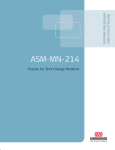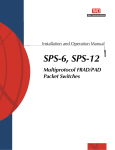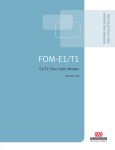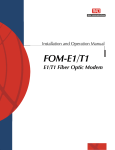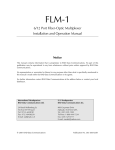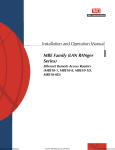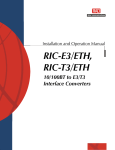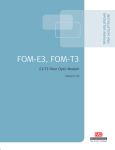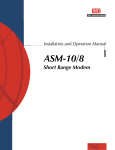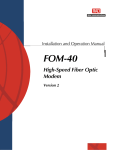Download RAD Data comm ASM-60 Specifications
Transcript
Installation and Operation Manual
ASM-61
2-Wire Symmetric
VDSL-Based Modem
Version 1.0
ASM-61
2-Wire Symmetric VDSL-Based Modem
Version 1.0
Installation and Operation Manual
Notice
This manual contains information that is proprietary to RAD Data Communications Ltd. ("RAD"). No
part of this publication may be reproduced in any form whatsoever without prior written approval by
RAD Data Communications.
Right, title and interest, all information, copyrights, patents, know-how, trade secrets and other
intellectual property or other proprietary rights relating to this manual and to the ASM-61 and any
software components contained therein are proprietary products of RAD protected under international
copyright law and shall be and remain solely with RAD.
ASM-61 is a registered trademark of RAD. No right, license, or interest to such trademark is granted
hereunder, and you agree that no such right, license, or interest shall be asserted by you with respect
to such trademark.
You shall not copy, reverse compile or reverse assemble all or any portion of the Manual or the
ASM-61. You are prohibited from, and shall not, directly or indirectly, develop, market, distribute,
license, or sell any product that supports substantially similar functionality as the ASM-61, based on or
derived in any way from the ASM-61. Your undertaking in this paragraph shall survive the termination
of this Agreement.
This Agreement is effective upon your opening of the ASM-61 package and shall continue until
terminated. RAD may terminate this Agreement upon the breach by you of any term hereof. Upon
such termination by RAD, you agree to return to RAD the ASM-61 and all copies and portions thereof.
For further information contact RAD at the address below or contact your local distributor.
International Headquarters
RAD Data Communications Ltd.
North America Headquarters
RAD Data Communications Inc.
24 Raoul Wallenberg St.
Tel Aviv 69719 Israel
Tel: 972-3-6458181
Fax: 972-3-6498250
E-mail: [email protected]
900 Corporate Drive
Mahwah, NJ 07430 USA
Tel: (201) 529-1100, Toll free: 1-800-444-7234
Fax: (201) 529-5777
E-mail: [email protected]
© 1989–2006 RAD Data Communications Ltd.
Publication No. 182-200-01/06
Limited Warranty
RAD warrants to DISTRIBUTOR that the hardware in the ASM-61 to be delivered hereunder shall be
free of defects in material and workmanship under normal use and service for a period of twelve (12)
months following the date of shipment to DISTRIBUTOR.
If, during the warranty period, any component part of the equipment becomes defective by reason of
material or workmanship, and DISTRIBUTOR immediately notifies RAD of such defect, RAD shall have
the option to choose the appropriate corrective action: a) supply a replacement part, or b) request
return of equipment to its plant for repair, or c) perform necessary repair at the equipment's location.
In the event that RAD requests the return of equipment, each party shall pay one-way shipping costs.
RAD shall be released from all obligations under its warranty in the event that the equipment has been
subjected to misuse, neglect, accident or improper installation, or if repairs or modifications were
made by persons other than RAD's own authorized service personnel, unless such repairs by others
were made with the written consent of RAD.
The above warranty is in lieu of all other warranties, expressed or implied. There are no warranties
which extend beyond the face hereof, including, but not limited to, warranties of merchantability and
fitness for a particular purpose, and in no event shall RAD be liable for consequential damages.
RAD shall not be liable to any person for any special or indirect damages, including, but not limited to,
lost profits from any cause whatsoever arising from or in any way connected with the manufacture,
sale, handling, repair, maintenance or use of the ASM-61, and in no event shall RAD's liability exceed
the purchase price of the ASM-61.
DISTRIBUTOR shall be responsible to its customers for any and all warranties which it makes relating
to ASM-61 and for ensuring that replacements and other adjustments required in connection with the
said warranties are satisfactory.
Software components in the ASM-61 are provided "as is" and without warranty of any kind. RAD
disclaims all warranties including the implied warranties of merchantability and fitness for a particular
purpose. RAD shall not be liable for any loss of use, interruption of business or indirect, special,
incidental or consequential damages of any kind. In spite of the above RAD shall do its best to provide
error-free software products and shall offer free Software updates during the warranty period under
this Agreement.
RAD's cumulative liability to you or any other party for any loss or damages resulting from any claims,
demands, or actions arising out of or relating to this Agreement and the ASM-61 shall not exceed the sum
paid to RAD for the purchase of the ASM-61. In no event shall RAD be liable for any indirect, incidental,
consequential, special, or exemplary damages or lost profits, even if RAD has been advised of the
possibility of such damages.
This Agreement shall be construed and governed in accordance with the laws of the State of Israel.
General Safety Instructions
The following instructions serve as a general guide for the safe installation and operation of
telecommunications products. Additional instructions, if applicable, are included inside the manual.
Safety Symbols
Warning
This symbol may appear on the equipment or in the text. It indicates
potential safety hazards regarding product operation or maintenance to
operator or service personnel.
Danger of electric shock! Avoid any contact with the marked surface while
the product is energized or connected to outdoor telecommunication lines.
.
Protective earth: the marked lug or terminal should be connected to the building
protective earth bus.
Warning
Some products may be equipped with a laser diode. In such cases, a label
with the laser class and other warnings as applicable will be attached near
the optical transmitter. The laser warning symbol may be also attached.
Please observe the following precautions:
• Before turning on the equipment, make sure that the fiber optic cable is
intact and is connected to the transmitter.
• Do not attempt to adjust the laser drive current.
• Do not use broken or unterminated fiber-optic cables/connectors or look
straight at the laser beam.
• The use of optical devices with the equipment will increase eye hazard.
• Use of controls, adjustments or performing procedures other than those
specified herein, may result in hazardous radiation exposure.
ATTENTION: The laser beam may be invisible!
In some cases, the users may insert their own SFP laser transceivers into the product. Users are alerted
that RAD cannot be held responsible for any damage that may result if non-compliant transceivers are
used. In particular, users are warned to use only agency approved products that comply with the local
laser safety regulations for Class 1 laser products.
Always observe standard safety precautions during installation, operation and maintenance of this
product. Only qualified and authorized service personnel should carry out adjustment, maintenance or
repairs to this product. No installation, adjustment, maintenance or repairs should be performed by
either the operator or the user.
Handling Energized Products
General Safety Practices
Do not touch or tamper with the power supply when the power cord is connected. Line voltages may be
present inside certain products even when the power switch (if installed) is in the OFF position or a fuse is
blown. For DC-powered products, although the voltages levels are usually not hazardous, energy hazards
may still exist.
Before working on equipment connected to power lines or telecommunication lines, remove jewelry or any
other metallic object that may come into contact with energized parts.
Unless otherwise specified, all products are intended to be grounded during normal use. Grounding is
provided by connecting the mains plug to a wall socket with a protective earth terminal. If an earth lug is
provided on the product, it should be connected to the protective earth at all times, by a wire with a
diameter of 18 AWG or wider. Rack-mounted equipment should be mounted only in earthed racks and
cabinets.
Always make the ground connection first and disconnect it last. Do not connect telecommunication cables
to ungrounded equipment. Make sure that all other cables are disconnected before disconnecting the
ground.
Connection of AC Mains
Make sure that the electrical installation complies with local codes.
Always connect the AC plug to a wall socket with a protective ground.
The maximum permissible current capability of the branch distribution circuit that supplies power to the
product is 16A. The circuit breaker in the building installation should have high breaking capacity and must
operate at short-circuit current exceeding 35A.
Always connect the power cord first to the equipment and then to the wall socket. If a power switch is
provided in the equipment, set it to the OFF position. If the power cord cannot be readily disconnected in
case of emergency, make sure that a readily accessible circuit breaker or emergency switch is installed in the
building installation.
In cases when the power distribution system is IT type, the switch must disconnect both poles
simultaneously.
Connection of DC Mains
Unless otherwise specified in the manual, the DC input to the equipment is floating in reference to the ground.
Any single pole can be externally grounded.
Due to the high current capability of DC mains systems, care should be taken when connecting the DC supply
to avoid short-circuits and fire hazards.
DC units should be installed in a restricted access area, i.e. an area where access is authorized only to
qualified service and maintenance personnel.
Make sure that the DC supply is electrically isolated from any AC source and that the installation complies
with the local codes.
The maximum permissible current capability of the branch distribution circuit that supplies power to the
product is 16A. The circuit breaker in the building installation should have high breaking capacity and must
operate at short-circuit current exceeding 35A.
Before connecting the DC supply wires, ensure that power is removed from the DC circuit. Locate the
circuit breaker of the panel board that services the equipment and switch it to the OFF position. When
connecting the DC supply wires, first connect the ground wire to the corresponding terminal, then the
positive pole and last the negative pole. Switch the circuit breaker back to the ON position.
A readily accessible disconnect device that is suitably rated and approved should be incorporated in the
building installation.
If the DC mains are floating, the switch must disconnect both poles simultaneously.
Connection of Data and Telecommunications Cables
Data and telecommunication interfaces are classified according to their safety status.
The following table lists the status of several standard interfaces. If the status of a given port differs from
the standard one, a notice will be given in the manual.
Ports
Safety Status
V.11, V.28, V.35, V.36, RS-530,
X.21, 10 BaseT, 100 BaseT,
Unbalanced E1, E2, E3, STM, DS-2,
DS-3, S-Interface ISDN, Analog voice
E&M
SELV
xDSL (without feeding voltage),
Balanced E1, T1, Sub E1/T1
TNV-1 Telecommunication Network Voltage-1:
FXS (Foreign Exchange Subscriber)
TNV-2 Telecommunication Network Voltage-2:
Safety Extra Low Voltage:
Ports which do not present a safety hazard. Usually
up to 30 VAC or 60 VDC.
Ports whose normal operating voltage is within the
limits of SELV, on which overvoltages from
telecommunications networks are possible.
Ports whose normal operating voltage exceeds the
limits of SELV (usually up to 120 VDC or telephone
ringing voltages), on which overvoltages from
telecommunication networks are not possible. These
ports are not permitted to be directly connected to
external telephone and data lines.
FXO (Foreign Exchange Office), xDSL
(with feeding voltage), U-Interface
ISDN
TNV-3 Telecommunication Network Voltage-3:
Ports whose normal operating voltage exceeds the
limits of SELV (usually up to 120 VDC or telephone
ringing voltages), on which overvoltages from
telecommunication networks are possible.
Always connect a given port to a port of the same safety status. If in doubt, seek the assistance of a
qualified safety engineer.
Always make sure that the equipment is grounded before connecting telecommunication cables. Do
not disconnect the ground connection before disconnecting all telecommunications cables.
Some SELV and non-SELV circuits use the same connectors. Use caution when connecting cables.
Extra caution should be exercised during thunderstorms.
When using shielded or coaxial cables, verify that there is a good ground connection at both ends. The
earthing and bonding of the ground connections should comply with the local codes.
The telecommunication wiring in the building may be damaged or present a fire hazard in case of
contact between exposed external wires and the AC power lines. In order to reduce the risk, there are
restrictions on the diameter of wires in the telecom cables, between the equipment and the mating
connectors.
Caution
Attention
To reduce the risk of fire, use only No. 26 AWG or larger telecommunication line cords.
Pour réduire les risques s’incendie, utiliser seulement des conducteurs de
télécommunications 26 AWG ou de section supérieure.
Some ports are suitable for connection to intra-building or non-exposed wiring or cabling only. In such
cases, a notice will be given in the installation instructions.
Do not attempt to tamper with any carrier-provided equipment or connection hardware.
Electromagnetic Compatibility (EMC)
The equipment is designed and approved to comply with the electromagnetic regulations of major
regulatory bodies. The following instructions may enhance the performance of the equipment and will
provide better protection against excessive emission and better immunity against disturbances.
A good earth connection is essential. When installing the equipment in a rack, make sure to remove all
traces of paint from the mounting points. Use suitable lock-washers and torque. If an external
grounding lug is provided, connect it to the earth bus using braided wire as short as possible.
The equipment is designed to comply with EMC requirements when connecting it with unshielded
twisted pair (UTP) cables. However, the use of shielded wires is always recommended, especially for
high-rate data. In some cases, when unshielded wires are used, ferrite cores should be installed on
certain cables. In such cases, special instructions are provided in the manual.
Disconnect all wires which are not in permanent use, such as cables used for one-time configuration.
The compliance of the equipment with the regulations for conducted emission on the data lines is
dependent on the cable quality. The emission is tested for UTP with 80 dB longitudinal conversion loss
(LCL).
Unless otherwise specified or described in the manual, TNV-1 and TNV-3 ports provide secondary
protection against surges on the data lines. Primary protectors should be provided in the building
installation.
The equipment is designed to provide adequate protection against electro-static discharge (ESD).
However, it is good working practice to use caution when connecting cables terminated with plastic
connectors (without a grounded metal hood, such as flat cables) to sensitive data lines. Before
connecting such cables, discharge yourself by touching earth ground or wear an ESD preventive wrist
strap.
FCC-15 User Information
This equipment has been tested and found to comply with the limits of the Class A digital device,
pursuant to Part 15 of the FCC rules. These limits are designed to provide reasonable protection
against harmful interference when the equipment is operated in a commercial environment. This
equipment generates, uses and can radiate radio frequency energy and, if not installed and used in
accordance with the Installation and Operation manual, may cause harmful interference to the radio
communications. Operation of this equipment in a residential area is likely to cause harmful
interference in which case the user will be required to correct the interference at his own expense.
Canadian Emission Requirements
This Class A digital apparatus meets all the requirements of the Canadian Interference-Causing
Equipment Regulation.
Cet appareil numérique de la classe A respecte toutes les exigences du Règlement sur le matériel
brouilleur du Canada.
Warning per EN 55022 (CISPR-22)
Warning
This is a class A product. In a domestic environment, this product may cause
radio interference, in which case the user will be required to take adequate
measures.
Avertissement
Cet appareil est un appareil de Classe A. Dans un environnement résidentiel, cet
appareil peut provoquer des brouillages radioélectriques. Dans ces cas, il peut
être demandé à l’utilisateur de prendre les mesures appropriées.
Achtung
Dieses ist ein Gerät der Funkstörgrenzwertklasse A. In Wohnbereichen können
bei Betrieb dieses Gerätes Rundfunkströrungen auftreten, in welchen Fällen der
Benutzer für entsprechende Gegenmaßnahmen verantwortlich ist.
Declaration of Conformity
Manufacturer's Name:
RAD Data Communications Ltd.
Manufacturer's Address:
24 Raoul Wallenberg St.
Tel Aviv 69719
Israel
declares that the product:
ASM-61
Product Name:
conforms to the following standard(s) or other normative document(s):
EMC:
Safety:
EN 55022: 1998
Information technology equipment, radio disturbance
characteristics, limits and methods of measurement.
EN 50024: 1998
Information technology equipment, immunity characteristics,
limits and methods of measurement.
EN 60950: 2000
Safety of information technology equipment.
Supplementary Information:
The product herewith complies with the requirements of the EMC Directive 89/336/EEC, the Low
Voltage Directive 73/23/EEC and the R&TTE Directive 99/5/EC for wired equipment. The product was
tested in a typical configuration.
Tel Aviv, 31st October, 2002
Haim Karshen
VP Quality
European Contact: RAD Data Communications GmbH, Otto-Hahn-Str. 28-30, 85521
Ottobrunn-Riemerling, Germany
Contents
Chapter 1. Introduction
1.1 Overview..................................................................................................................... 1-1
Product Options ................................................................................................................... 1-1
Application ........................................................................................................................... 1-1
Features................................................................................................................................ 1-1
1.2 Physical Description..................................................................................................... 1-3
1.3 Functional Description................................................................................................. 1-3
1.4 Technical Specifications............................................................................................... 1-4
Chapter 2. Installation
2.1 Site Requirements and Prerequisites ............................................................................ 2-1
2.2 Package Contents ........................................................................................................ 2-1
2.3 Installation and Setup .................................................................................................. 2-2
Connecting the Interfaces ..................................................................................................... 2-2
Connecting the Power .......................................................................................................... 2-3
Chapter 3. Operation
3.1 Front Panel Indicators .................................................................................................. 3-1
3.2 Operating ASM-61 ...................................................................................................... 3-2
Turning On ASM-61 ............................................................................................................. 3-2
Normal Operation ................................................................................................................ 3-2
Turning Off ASM-61 ............................................................................................................. 3-2
ASM-61 Ver. 1.0
i
Table of Contents
ii
Installation and Operation Manual
ASM-61 Ver. 1.0
Chapter 1
Introduction
1.1
Overview
ASM-61 is a dedicated carrier-class VDSL (Very High-bitrate Digital Subscriber
Line) modem operating at symmetrical line rate of 10 Mbps. ASM-61 serves for
transporting 10/100BaseT Ethernet traffic over 2-wire line using VDSL technology.
Product Options
ASM-61 always operates in pairs:
•
ASM-61/CO, for the central office deployment
•
ASM-61/CPE, for customer premises deployment.
Application
Figure 1-1 shows a typical application for ASM-61, connecting two LANs over
2-wire line.
Figure 1-1. Typical Application
Features
ASM-61 utilizes the QAM-based modulation to extend the range of 10/100BT data
transmission over 2-wire 24 AWG line up to 1 km (0.6 miles), operating at
10 Mbps line rate. Table 1-1 lists line attenuations for 1 km range at 6.05 MHz for
different cable types.
ASM-61 Ver. 1.0
Overview
1-1
Chapter 1 Introduction
Installation and Operation Manual
Table 1-1. Line Attenuation
Cable Type
Attenuation
[dB]
PIC 0.4 mm/26 AWG
-66.0
PIC 0.5 mm/24 AWG
-53.0
PE 0.4 mm/26 AWG
-64.2
PE 0.5 mm/24 AWG
-50.0
PE 0.63 mm/22 AWG
-41.4
PE 0.9 mm/19 AWG
-29.1
FP 1.14 mm
-49.7
CAT-3
-71.5
CAT-5
-50.0
DTE Interface
The ASM-61 DTE interface is an Ethernet/Fast Ethernet port with VLAN support.
The plug-and-play 10/100BT interface uses on-chip autonegotiation algorithm to
configure itself automatically for 10 Mbps or 100 Mbps half- or full-duplex
operation.
Management
Operating with the constant line rate and preset timing modes, ASM-61 does not
require any user configuration.
Timing
ASM-61/CO operates with internal clock, and ASM-61/CPE uses clock received
from the line.
Synchronization
ASM-61 units reach synchronization in about 15 seconds at cold restart (power-on)
and in less than one second at warm restart.
Test Capabilities
ASM-61 performs an extensive self-test at start-up. During the self-test, ASM-61
checks its CPU, internal framer, DTE/line interfaces and power supply.
1-2
Overview
ASM-61 Ver. 1.0
Installation and Operation Manual
1.2
Chapter 1 Introduction
Physical Description
Figure 1-2 shows a 3D view of the ASM-61 standalone modem.
Figure 1-2. 3D View of ASM-61
The front panel includes three LEDs, which display the status of power, line
synchronization status and LAN activity status. For detailed description of the front
panel, see Chapter 3.
The rear panel includes power connector, LAN interface connectors and a line
connector. The ASM-61 rear panel is described in greater detail in Chapter 2.
1.3
Functional Description
This section provides a functional description (Figure 1-3) of ASM-61 in the form of
block diagram.
Line
Connector
CMC
VDSL Filter
& Hybrid
VDSL Line
Driver
VDSL
Analog
Chip
VDSL Analog Block
Ethernet
Connector
Ethernet
Magnetic
Ethernet
Chip
MII
Interface
VDSL Data
Pump
VDSL Digital
Block
Ethernet Block
Figure 1-3. ASM-61 Block Diagram
ASM-61 Ver. 1.0
Functional Description
1-3
Chapter 1 Introduction
Installation and Operation Manual
The modem consists of the following major modules:
• Ethernet Block includes an external Ethernet component configured as a
single PHY and connected in one end at LAN interface by passive components
and to the second end to a standard Ethernet device acting as MAC (Media
Access Controller). By autonegotiation procedure each MAC can configure its
Ethernet PHY independently of the remote site. The configuration parameters
are: 10 Mbps or 100 Mbps, half or full duplex, backpressure in half duplex.
MII serial management configures all those parameters to PHY. It also includes
embedded 8-kilobyte Ethernet transmit and 16-kilobyte Ethernet receive
buffers.
• VDSL Digital Block is based on a QAM VDSL data pump serving as an
Ethernet physical layer. The VDSL digital block operates as a master (CO) or
slave (CPE). It includes an Ethernet interface, an AFE interface, an embedded
micro-controller for standalone operation and monitoring. VDSL digital block
is built around a DSP, which is based on a QAM VDSL data pump serving as
an Ethernet physical layer. It includes an Ethernet interface (described above),
an AFE interface, and an embedded micro-controller for standalone operation
and monitoring. In addition, it provides an embedded operation channel for
the control of remote unit. The VDSL digital block operates at symmetrical line
rate of 12.5 Mbps, including the standard VDSL channels, delivering a user
data payload at 11.25 Mbps. This block operates as ‘master’ (CO) or ‘slave’
(CPE). The VDSL digital block complies with VDSL standard requirements in
respect of data randomizer support, Reed-Solomon forward error correction
(FEC) and convolution interleave algorithm for noisy environment and poor
quality lines. The DSP configures the DSL analog block via the AFE interface.
• VDSL Analog Block is built around the VDSL-A analog chip. It employs an
external crystal oscillator to provide timing for the system. Analog output from
the VDSL analog chip drives the differential line driver. The VDSL filters and
hybrid perform upstream and downstream channel separation.
1.4
Line Interface
1-4
Technical Specifications
Protocol
Very High-bit-rate Digital Subscriber Line (VDSL)
Type
2-wire, unconditioned dedicated lines (twisted pair)
Line Rate
10 Mbps, symmetric
Payload Rate
Greater than 10 Mbps, symmetric (11.25 Mbps)
Line Coding
QAM-based
Range
1 km (0.6 miles)
Duplexing Method
Frequency Division Duplexing (FDD)
Synchronization
Link activation less than 1 sec at warm restart, with
blind timing recovery and blind training algorithm
Line Impedance
100Ω
Output Power
10 dBm
Technical Specifications
ASM-61 Ver. 1.0
Installation and Operation Manual
Chapter 1 Introduction
Line Attenuation
See Table 1-1
Power Spectral
Density
-58 dBm/Hz to -98 dBm/Hz, as per ETSI TS 1012701 requirements
Spectral Placement
Downstream: 0.9 MHz to 3.5 MHz
Upstream: 4 MHz to 7.9 MHz
Connector
RJ-45; pin 4 and pin 5
Network Topology
Ethernet extension
Port
One 10/100 Mbps LAN
Autonegotiation
Always enabled (for appropriate configuration mode)
Standard
IEEE 802.3, IEEE 802.3q
Mode
Half-duplex, full-duplex, backpressure support
Maximum Packet Size
1536 bytes
Backpressure
Always ON
Latency
2.5 msec for 1518-byte packet (end-to-end)
Connector
RJ-45
Diagnostics
Self-Test
Self-test at startup
Indicators
PWR (green)
Power
SYNC (green/red)
VDSL line synchronization
LAN (yellow)
Ethernet traffic is detected
ACT (yellow)
Ethernet traffic is detected
LINK (green)
Good link integrity
10/10Base-T
Interface
Physical
Power
Environment
ASM-61 Ver. 1.0
Height
44 mm (1.7 in 1U)
Width
237 mm (9.3 in)
Depth
170 mm (6.7 in)
Weight
0.58 kg (1.4 lb)
Combined AC/DC
100 to 240 VAC (±10%), 50 to 60 Hz, 4.6W
-48 VDC (-36 to -72 VDC), 7W
Fuse
0.250A, slow-blow
Temperature
0–50°C (32–122°F)
Humidity
Up to 90%, non–condensing
Technical Specifications
1-5
Chapter 1 Introduction
1-6
Technical Specifications
Installation and Operation Manual
ASM-61 Ver. 1.0
Chapter 2
Installation
This chapter describes installation and setup procedures for the standalone
ASM-61 modem.
After installing the unit, refer to Chapter 3 for the operating instructions.
Warning
Note
Internal settings, adjustment, maintenance, and repairs may be performed
only by a skilled technician who is aware of the hazards involved.
Always observe standard safety precautions during installation, operation, and
maintenance of this product.
Before installing the product, review Handling Energized Products at the beginning
of the manual.
2.1
Site Requirements and Prerequisites
ASM-61 has a combined AC/DC power supply. Units should be installed within
1.5m (5 ft) of an easily accessible grounded AC outlet furnishing 100 VAC to
240 VAC or DC power source of –48 VDC.
For instructions on connecting ASM-61 to a DC power source, see the DC Power
Supply Connection Supplement.
Allow at least 90 cm (36 in) of frontal clearance for operating and maintenance
accessibility. Allow at least 10 cm (4 in) clearance at the rear of the unit for signal
lines and interface cables.
The ambient operating temperature of ASM-61 is 0 to 50°C (32 to 122°F) at
relative humidity of 90%, non-condensing.
2.2
Package Contents
The ASM-61 package includes the following items:
ASM-61 Ver. 1.0
•
One ASM-61 unit
•
Last Mile Access and Intelligent Modems CD
•
AC/DC power cord.
Package Contents
2-1
Chapter 2 Installation
Installation and Operation Manual
2.3
Installation and Setup
ASM-61 is delivered completely assembled. It is designed for tabletop, wall or
19-inch rack installation.
The ASM-61/CO units are installed at the central site, ASM-61/CPE units are
installed at the remote site.
To install an ASM-61 unit:
1. Connect the line (see Connecting the Line below).
2. Connect the DTE (see Connecting the DTE below).
3. Connect power to the unit (see Connecting the Power below).
Connecting the Interfaces
Figure 2-1 shows the rear panel of a typical ASM-61 unit.
10/100BASE-T
LINE
4 5
Figure 2-1 ASM-61 Rear Panel
Connecting the Line
The ASM-61 line interface terminates in an RJ-45 connector (pin 4 and pin 5).
To connect the RJ-45 connector:
•
Connect the line cable to the RJ-45 connector designated LINE.
Connecting the DTE
The ASM-61 DTE interface provides interface for input/output data according to
autonegotiation procedures, clock reference and control signals between the
modem and the DTE. The ASM-61 DTE interface is 10/100BaseT port, which
terminates in an RJ-45 connector (see Table 2-1 for the connector pinout).
To connect the DTE interface:
•
2-2
Connect the Ethernet cable to the RJ-45 connector designated 10/100BASE-T.
Installation and Setup
ASM-61 Ver. 1.0
Installation and Operation Manual
Chapter 2 Installation
Table 2-1. 10/100BASE-T Connector Pinout
Pin
Signal
1
Rx +
2
Rx -
3
Tx +
4
–
5
–
6
Tx -
7
–
8
–
Connecting the Power
Warning
Before switching on this unit and connecting or disconnecting any other cable,
the protective earth terminals of this unit must be connected to the protective
ground conductor of the power cord. If you are using an extension cord
(power cable) make sure it is grounded as well.
Any interruption of the protective (grounding) conductor (inside or outside the
instrument) or disconnecting of the protective earth terminal can make this
unit dangerous. Intentional interruption is prohibited.
The line fuse is located in an integral-type fuse holder located on the rear
panel. Make sure that only fuses of the required rating, as marked on the rear
panel, are used for replacement. Do not use repaired fuses or short-circuit the
fuse holder. Always disconnect the mains cable before removing or replacing
the fuse. Whenever it is likely that the fuse protection has been damaged,
make the unit inoperative and secure it against unintended operation.
AC power is supplied to the ASM-61 modem through a standard 3-prong plug
with an integral fuse holder (see Figure 2-1). A cable 1.5m (5 ft) is provided with
the unit.
To connect the AC power:
1. Connect the power cable to the power connector on the ASM-61 rear panel.
2. Connect the power cable to the mains outlet.
The unit will be turned on automatically upon connection to the mains.
To connect the DC power:
•
ASM-61 Ver. 1.0
See the DC Power Supply Connection Supplement.
Installation and Setup
2-3
Chapter 2 Installation
2-4
Installation and Setup
Installation and Operation Manual
ASM-61 Ver. 1.0
Chapter 3
Operation
This chapter provides the description of the ASM-61 front-panel indicators, and
details the modem's operating procedures (turn-on, front-panel indications,
performance monitoring and turn-off).
Installation procedures given in Chapter 2 must be completed and checked before
attempting to operate ASM-61.
3.1
Front Panel Indicators
The front panel of ASM-61 includes three LED indicators that show the current
operating status of the unit.
Figure 3-1 shows the ASM-61 front panel. Table 3-1 lists and describes the ASM-61
indicators.
ASM-61
Figure 3-1 ASM-61 Front Panel
Table 3-1. ASM-61 LED Indicators
Name
Function
Location
PWR (green)
On – Power is On
Front panel
SYNC (red/green)
On (red) – Data link is not synchronized with the remote modem
On (green) – Data link is synchronized with the remote modem
Front panel
LAN (yellow)
On – Traffic from attached DTE is detected
Off – No traffic detected
Front panel
LINK (green)
On – Ethernet link is properly connected
Off – Ethernet link is disconnected
10/100BASE-T
connector
ACT (yellow)
On – Traffic from attached DTE is detected
Off – No traffic detected
10/100BASE-T
connector
ASM-61 Ver. 1.0
Front Panel Indicators
3-1
Chapter 3 Operation
3.2
Installation and Operation Manual
Operating ASM-61
Turning On ASM-61
ASM-61 is turned on as soon as the power is connected to the unit. The PWR
indicator lights up and remains lit as long as ASM-61 receives power.
Normal Operation
Always operate ASM-61 in pairs: ASM-61/CO opposite ASM-61/CPE.
ASM-61 units operate with the constant line rate (10 Mbps) and preset timing
modes (ASM-61/CO – internal, ASM-61/CPE – received).
Note
If a DTE attached to ASM-61 does not support autonegotiation, the modem
automatically switches to half duplex mode at 10 Mbps or 100 Mbps.
ASM-61 requires no operator attention once installed and powered up, with the
exception of occasional monitoring of front panel indicators.
Turning Off ASM-61
To turn off ASM-61, remove the power cord from the power source.
3-2
Operating ASM-61
ASM-61 Ver. 1.0
24 Raoul Wallenberg St., Tel Aviv 69719, Israel
Tel: +972-3-6458181, Fax: +972-3-6483331, +972-3-6498250
E-mail: [email protected], Web site: www.rad.com
Customer Response Form
RAD Data Communications would like your help in improving its product documentation.
Please complete and return this form by mail or by fax or send us an e-mail with your
comments.
Thank you for your assistance!
ASM-61
Manual Name: ______________________________________________________________
182-200-01/06
Publication Number: __________________________________________________________
Please grade the manual according to the following factors:
Installation instructions
Operating instructions
Manual organization
Illustrations
The manual as a whole
Excellent
Good
Fair
Poor
Very Poor
❒
❒
❒
❒
❒
❒
❒
❒
❒
❒
❒
❒
❒
❒
❒
❒
❒
❒
❒
❒
❒
❒
❒
❒
❒
What did you like about the manual?
___________________________________________________________________________
___________________________________________________________________________
___________________________________________________________________________
___________________________________________________________________________
___________________________________________________________________________
Error Report
Type of Error(s)
❒
Incompatibility with product
or Problem(s):
❒
Difficulty in understanding text
❒
Regulatory information (Safety, Compliance, Warnings, etc.)
❒
Difficulty in finding needed information
❒
Missing information
❒
Illogical flow of information
❒
Style (spelling, grammar, references, etc.)
❒
Appearance
❒
Other _________
Please list the exact page numbers with the error(s), detail the errors you found (information missing,
unclear or inadequately explained, etc.) and attach the page to your fax, if necessary.
_________________________________________________________________________________________
_________________________________________________________________________________________
_________________________________________________________________________________________
_________________________________________________________________________________________
Please add any comments or suggestions you may have.
_________________________________________________________________________________________
_________________________________________________________________________________________
_________________________________________________________________________________________
You are:
❒
Distributor
❒
End user
❒
VAR
❒
Other ________________________
Who is your distributor?
_______________________________
Your name and company: ___________________________________________________________
Job title: __________________________________________________________________________
Address: __________________________________________________________________________
Direct telephone number and extension: _______________________________________________
Fax number: ______________________________________________________________________
E-mail: _____________________________________________________________________
www.rad.com
INTERNATIONAL HEADQUARTERS:
24 Raoul Wallenberg Street, Tel Aviv 69719, Israel, Tel: 972-3-6458181
Fax: 972-3-6498250, 972-3-6474436, Email: [email protected]
NORTH AMERICA HEADQUARTERS:
900 Corporate Drive, Mahwah, N.J. 07430, Tel: (201) 529-1100
Toll Free: 1-800-444-7234, Fax: (201) 529-5777, Email: [email protected]
Publication No. 182-200-01/06






























